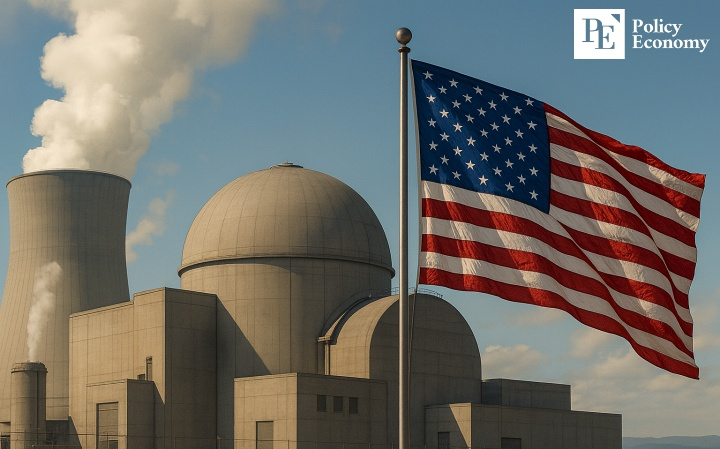Trump Signals End of Renewable Energy With “Scam of the Century” Remark, Intensifying Economic Debate
Input
Modified
U.S. Government Formalizes Policy Shift Counterarguments Cite Solar’s Price Competitiveness “Comparisons Without External Costs Are Meaningless”

President Donald Trump has launched a blistering attack on solar and wind power, declaring that his administration will not approve new projects. With uncertainty continuing to cloud the renewable energy industry, Trump framed the move as a brake on what he called reckless expansion. Critics, however, argue that the cost of solar and wind has already fallen below that of fossil fuels. Experts counter that without factoring in external costs, such comparisons are meaningless. Market sentiment, in turn, appears to be shifting from cost competitiveness toward grid stability and the durability of government policy.
Rising Concerns Over “High Costs and Farmland Destruction”
On the 20th, Trump wrote on his social media platform Truth Social: “In states that rely on wind turbines and solar panels as major power sources, we are seeing record increases in electricity and energy costs. This is the scam of the century.” He added: “We will no longer approve solar or wind farms that destroy farmland. The age of foolishness in America is over.”
In another post, Trump cited an interview with EPA Administrator Lee Zeldin, declaring: “No more tolerance. All green subsidies riddled with waste and abuse are being eliminated.” He claimed that “the amount canceled so far exceeds $29 billion, more than three times the EPA’s annual operating budget.”
This is not the first time Trump has voiced hostility toward renewables. During his first term, he railed against the high costs of building and maintaining wind and solar infrastructure. In July, while golfing in Scotland, he spotted wind turbines and called them “the most expensive form of energy,” adding that “after seven or eight years they start to rust and rot, and you can neither shut them down nor burn them.”
The U.S. government’s policy stance has also aligned with Trump’s views. On the 18th, Agriculture Secretary Brooke Rollins announced that the department would no longer support wind and solar projects on highly productive farmland. “Millions of acres of fertile land have been rendered unusable because of solar panel construction financed by Green New Deal subsidies,” Rollins said. “Destroying such fertile soil robs future generations of farmers and undermines our nation’s future.”
Falling Costs, Renewables Surpass Nuclear in Europe
Contrary to Trump’s claims of inefficiency, renewables are rapidly becoming cost-competitive. According to the International Renewable Energy Agency (IRENA), the global average levelized cost of electricity (LCOE) for solar power last year was 4.4 cents per kilowatt-hour, far below fossil fuels at 10 cents. Onshore wind averaged 3.3 cents, and offshore wind 7.5 cents, both cheaper than fossil fuels. The LCOE measures the total costs involved in producing a given amount of electricity.
Growing scrutiny has also been directed at claims that nuclear is cheaper. Analysts point out that studies comparing nuclear’s costs to wind and solar often exclude external costs such as grid expansion, accident risk, and waste management. Opponents argue that true nuclear costs must include expenses ranging from initial design to decommissioning, as well as the disposal of high-level radioactive waste and the social costs of site selection.
The rising share of renewables underscores this point. A study by the U.K.-based think tank Ember found that in June, solar power accounted for 22.1 percent of the European Union’s electricity generation, surpassing nuclear at 21.8 percent. Coal’s share fell to a record low of 6.1 percent. This shift shows that renewables are no longer auxiliary sources but have become primary energy providers.
Chris Rosslow, senior analyst at Ember, noted, “Solar output surged due to summer heatwaves, but it also shows how quickly the EU’s power system is changing.” He added, “Low-cost renewables are helping Europe break free from fossil fuel price volatility. The next challenge is to maximize renewable use during mornings and evenings, when solar is weaker, through battery storage and flexible grids.”

Unit Cost Comparisons Lose Meaning
Still, advocates for nuclear continue to stress its cost advantage. A cost-per-unit analysis released last year by the South Korean government showed that producing 1 kilowatt-hour of electricity from nuclear required 36 cents, while solar required $2.45—6.8 times more. Nuclear also required only 78 square meters of land per gigawatt-hour, compared with 13,235 square meters for solar, a difference of 179 times. Factoring in the need for large-scale energy storage systems (ESS) to offset the intermittency of renewables would push solar’s costs even higher.
Yet experts caution against reducing the debate to price alone. Nuclear plants take more than a decade to design and build, but once completed they can run stably for decades. Solar and wind can be installed and activated within a year, but their output depends heavily on weather conditions, making backup systems essential. Ignoring such structural differences makes cost comparisons misleading.
The challenges facing both energy sources go far beyond cost disputes. Renewables require large-scale storage and expanded transmission networks to overcome intermittency. For example, when solar power peaks during the day, excess electricity must be stored or transmitted elsewhere. Nuclear, on the other hand, faces critical challenges in waste management and safety, with decommissioning costs and high-level waste disposal demanding attention. These difficult-to-quantify burdens significantly shape each energy source’s prospects.
This is why the market is increasingly focused not only on cost but also on stability and policy sustainability. Cost-based debates lose relevance if they fail to reflect the structural realities each energy source faces. As state-led renewable expansion delivers only limited gains in grid stability, market participants argue that debates framed solely around price are little more than numerical contests that fail to capture the deeper differences between power generation systems.





















